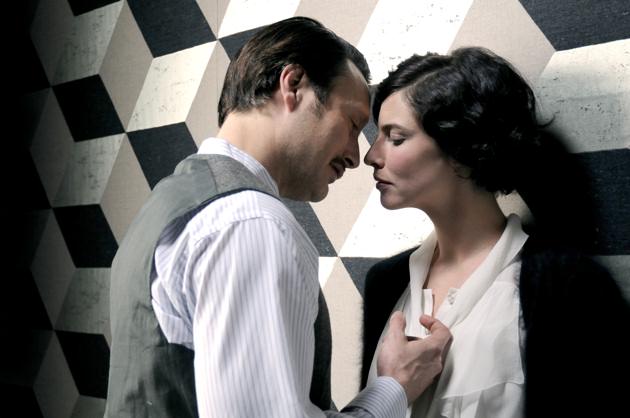All bio-pix are by definition ridiculous since their subjects have to be manifestly unique people—why else would the movie be made?—while what makes them unique is exactly what’s so impossible to convey. (Creativity is invisible, hence unfilmable.) At best, what you get is the kind of superior impersonation Meryl Streep is so adept at, from Isak Dinesen to Julia Child, or that motored not one but two faux-Capotes a few years ago. (The best such recent effort was Marion Cotillard’s Oscar-winning turn as Edith Piaf. The movie itself was standard stuff, but Cotillard’s performance seemed less like an impersonation and more like the real thing—or a real thing.)
Hollywood once majored in stuff of this kind. Through the decades geniuses suffered—the uplifting stories of Louis Pasteur, Madame Curie, and Dr. Erlich (and his Magic Bullet)—and artists suffered: the tormented trajectories of Chopin, Van Gogh, Michelangelo. Later came the entertainment icons—Al Jolson, Billie Holiday, Ray Charles, and their endless spawn on TV Lifetime specials. And then there’s the world of Classica—Alexander, the Macedonian who’s had the distinction of being portrayed by a Welshman (Richard Burton) and an Irishman (Colin Farrell); Cleopatra—you know who played her; and—still around in a few obscure and empty theatres—that renowned early-fifth-century Alexandrian astronomer and mathematician Hypatia, in a Rachel Weisz ego-trip titled Agora. (She’s murdered by a Christian mob.)
The latest stab at showing us how genius operates is Coco Chanel & Igor Stravinsky, a swanky re-enactment of the supposed flaming affair between two of the major creative forces of the last century. (In real life, they did—or didn’t?— share a brief moment.) Why and for whom was this movie made? There’s no big name attached to it—it was never headed for your local Cineplex. One possible clue: Anna Mouglalis, who plays Chanel, has worked for the fashion house for eight years, and remains a “muse” for Karl Lagerfeld’s Chanel products. Is this what’s meant by “synergy”?
Mouglalis is a great beauty—the closest thing we’ve seen to Ava Gardner since Ava Gardner. And beauty is the main thing the movie offers—every approving review gloats over the opulence and glamour of the period sets and costumes; it’s Masterpiece Theatre meets The Rite of Spring. Which is indeed how the movie opens: with a meticulous and convincing re-enactment of the famous “scandal”—the boos, the catcalls—of the 1913 premiere of that Stravinsky/Nijinsky/Diaghilev cause célèbre. Coco, elegantly strapless, is on hand, coolly approving while taking note of the hunky young composer (Mads Mikkelsen). Here, to anyone who knows the Stravinsky iconography, is where a willing suspension of disbelief had better start kicking in: Stravinsky was many extraordinary things, but at 5′ 3″ and with his owl-like visage he was no hunk. In the last few years, Helen Mirren, in a burst of verisimilitude, sported Her Majesty the Queen’s signature hairdo and Nicole Kidman proudly asserted Virginia Woolf’s nose. Coco & Igor is much too busy with the verisimilitude of the furniture and the drapery to bother with what its iconic protagonists really looked like.
World War I comes and goes, and the Stravinskys are on their uppers, needing a place to perch while the great man Creates. Coco has not forgotten him, and offers Igor and his little woman and their four littler ones her superb country estate to live and work in. (Cosily, she’ll be there too.) Madame S, who’s suffering from jealousy as well as tuberculosis, is understandably miserable, but tant pis—what must be, must be when two voracious geniuses are living under one roof, particularly when they’re so well dressed.
Despite all its pretensions, Coco & Igor is just the same old Hollywood story: a selfish and tormented hero is torn between a ruthless Joan Crawford and a self-sacrificial Lillian Gish. Poor Catherine Stravinsky (Elena Morozova, in the film’s only convincing performance) confronts Coco: Think of the children. Have you no heart? And you’ll be stunned to hear that beneath her coldness, her ruthlessness, her straplessness, she does have a heart, and subtly engineers a quarrel with her lover, so that the Stravinskys are forced to decamp with the family more or less intact. But not before we’ve been treated to a variety of embarrassing sex scenes: it’s just plain mortifying to find yourself contemplating Igor Stravinsky’s bare buttocks pumping away over Coco Chanel’s bare everything. For comic relief, though, we do get Igor teaching Coco how to play the piano in two minutes. (She doesn’t reciprocate by teaching him how to sew, although she does stitch on one of his buttons.)
Advertisement
There’s been a run on Chanel lately: not only last year’s Audrey Tautou movie Coco Before Chanel (actually, she was Gabrielle before she was Coco), but a couple of years ago a TV movie with Shirley MacLaine (!) as the mature Chanel. Neither of these films was exactly persuasive. Even so, in the dialogue department the new movie wins hands down. The epic spat between the two monstres sacrés goes as follows:
She: “I’m as powerful as you, Igor, and more successful.”
He: “You’re not an artist, you’re a shopkeeper.”
End of affair.
Well, Chanel was a shopkeeper (and what a shop!), and she would undoubtedly have acknowledged it: She was above all else a realist. Diana Vreeland put it this way: “Peasants and geniuses are the only people who count, and she was both.” And “Coco was never a kind woman … But she was the most interesting person I’ve ever met.” I just wish D.V. had lived long enough to see her and her equally prodigious lover portrayed not as the earth-shaking revolutionaries they were but as props in a high-toned soap opera.
Coco Chanel & Igor Stravinsky, a film directed by Jan Kounen, is playing at Quad Cinemas in New York, and is in wide release elsewhere.



